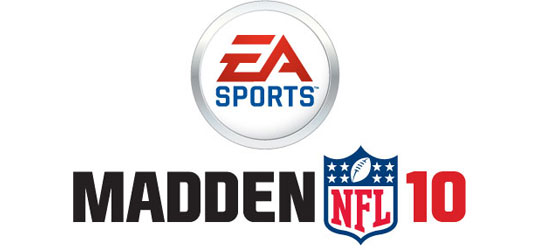
Due out on the Xbox 360 and PS3 come August 14th, EA Sports’ Madden NFL 10 will feature a new Online Franchise mode, which a newly-released video today talks about. The Online Franchise mode allows players to pit their teams against each other in a full, simulated NFL season! 32 teams will participate in each season and those that do not get filled by a human being will be AI-controlled. This virtual season will also have player-trading and even let iPhone/iPod Touch users manage their teams with their respective devices.
Author - Jerry Paxton

Microsoft has announced the recommended price points for both the full and upgrade versions of their upcoming Windows 7 OS. Due out October 22nd, the new operating system pricing breaks down like so:
Upgrade Versions
* Windows 7 Home Premium (Upgrade): $119.99
* Windows 7 Professional (Upgrade): $199.99
* Windows 7 Ultimate (Upgrade): $219.99
Full Versions
* Windows 7 Home Premium (Full): $199.99
* Windows 7 Professional (Full): $299.99
* Windows 7 Ultimate (Full): $319.99
Also, if you want to pre-order the OS tomorrow, Microsoft is offering a 50% discount to all versions except the Ultimate Edition (darn it). This 50% discount offer is valid until July 11th.
Via WindowsTeamBlog
When Amazon released its Kindle 2 in February of this year, I thought my prayers had been answered. That device saw the re-design of the original Kindle along with a newer E-Ink display as well as increased storage capacity, things were looking up for my e-reader purchasing needs. However, I held-fast and did not buy right away as I remember several experiences with being an early adopter that ended up biting me in the rear end. Thankfully my gambit paid off and in April of this year Amazon announced the Kindle DX.
As you can see, the Kindle DX looks very similar to the Kindle 2 but obviously much larger in size. It measures 10.4” by 7.2” and is 0.38” in thickness. Like the previous Kindles, the DX features a white exterior with silver backing and very spartan style which wreaks of Apple-influence. Not that we are complaining, if you are going to lift the design style off of one company in today’s economy, Apple is a great choice.
Key differences from the Kindle 2 aside from size is that Kindle DX has a 9.7” (diagonal) E-Ink display. It is capable of the same 16-levels of grayscale as the Kindle 2’s screen – its just bigger. In fact, the Kindle DX’s screen is about the exact same size as the entire Kindle 2 device! The control-array on the right side of the DX is similar to the array on the Kindle 2, however the five-way directional nub is a bit more raised and usable on the Kindle DX. Another big change from the Kindle 2 is that the Kindle DX features a keyboard of reduced size which makes usage not as user-friendly as the previous model. Its odd-shape and size definitely take some getting used to. Amazon has included 4GB of internal memory on the Kindle DX, double that of the Kindle 2. However unlike the Kindle 2 the Kindle DX does NOT feature an SD memory card slot.
An internal sensor detects whether the Kindle DX is being held in landscape or portrait modes and rotates the display to match. This is a nice feature to have but I found myself sticking with portrait mode most often. This could have been just sheer force of habit or perhaps I did not have any e-docs that needed landscape reading. For normal reading needs, even in newspapers, the Kindle DX’s large screen does great in portrait mode.
Returning on this third Kindle device is the much-heralded, and controversial, text-to-speech feature from the Kindle 2. While the vocal reproductions are good they are still a far cry from actual human speech and I can’t imagine it being used in practical application. Besides, you are buying an E-Reader to read! If you wanted to listen to your books there are much cheaper options with better production values.
As far as its size is concerned, from a functionality-standpoint it is perfect for what Amazon has said is the Kindle DX’s core market: Educational institutions and business professionals. Jeff Bezos mentioned in his unveiling of the Kindle DX that the plan was to have educational institutions subsidize purchases of the DX for students and for textbook-producers to offer Kindle DX versions of their weighty products. Thus far this has not come to pass, but as a former-university student I can tell you that if I had the choice of carrying around all of the books I did or just the Kindle DX I would choose the E-Reader everytime. While the Kindle DX is an expensive device, if purchased for a discount at the beginning of one’s college career it could literally be the best investment you make besides the coffee you need to keep you going through all-night study groups.

As for you business professionals out there, you will probably enjoy the Kindle DX’s native PDF support. Unfortunately, you cannot do much with the PDF aside from view it. There is no way to zoom in on the document or anything like that. The Kindle DX simply scales the PDF to the size of the screen and displays it. While useful, if the PDF features very small text, it can become unreadable should the DX scale it down too much. Aside from this problem, if the PDF is created smartly, with moderately sized fonts, it allows for a very easy to carry around your memo’s, project proposals, etc.
As I mentioned before, the educational front of the Kindle DX features has been a bit too quiet for my tastes since the initial announcement. This piece of the puzzle alone could revolutionize how students move around from class to class. It will go far to alleviate student backstrain, that much is at least certain!
Unfortunately one of the best assets of the Kindle DX, its size, is also a bit of a downside as well. While having the extra screen real estate proves to be a much improved reading experience in comparison to the Kindle 2, it also makes it harder to carry around with you. Plus, Amazon still is not including a sleeve for the unit making you purchase one after the fact for around an extra $50 bucks! Seriously Amazon, for $489 dollars I want to have an included sleeve or cover.
The Kindle DX is not cheap. At $489 dollars it is an extremely weighty purchase. If you are already the owner of a Kindle E-Reader, you may want to pass this one by and wait for the Kindle 3 unless you can get a good re-sale amount to offset the Kindle DX’s price. However, if you are new to the E-Reader market, I would say go with a Kindle DX hands-down. It may not be a perfect device, but out of all the E-Readers on the market it is easily the best yet.
The Kindle DX Official Product Page
Armed Assault II, or ‘ArmA II’, is the sequel to the popular war game Armed Assault which was the spiritual successor to the popular war game Operation Flashpoint. If that last one sounds familiar to you, it is because Bohemia Interactive Studio (BIS) were the game’s developers under the watchful publishing of Codemasters Interactive. The upcoming sequel to Operation Flashpoint is, good or bad – depending on your view, not being developed by BIS. So now that the history lesson is over and done with let’s talk about Armed Assault II.
Armed Assault II is, like its predecessor, divided up into multiple areas of play. In the singleplayer modes you can train in multiple boot camp-style scenarios which do a fine job of preparing you for the various elements of gameplay you will encounter. The campaign can be played locally or hosted for your buddies to join in and is a real improvement over the first game’s campaign.
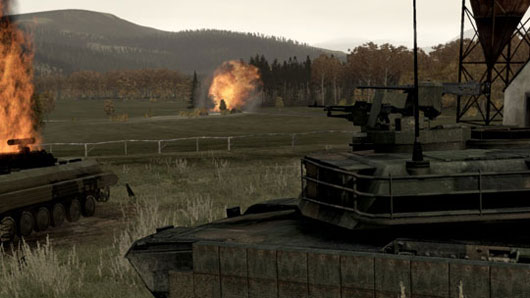
In Armed Assault 2 you find yourself on the ex-Soviet republic of Chernarus in a battle with multiple factions all duking it out for their own agendas. Your character is part of a United States Marine Corps Force Recon team known as ‘Razor’ and are the cream of the crop, as they say. However, don’t go thinking you are the bloody Master Chief here or anything – you are VERY vulnerable, as anyone who has played the original Armed Assault knows. Wounds are not taken lightly – a couple of moderate hits and you are a goner! Thankfully, this area of the hardcore gameplay has been toned a bit with the introduction of a first-aid system where team mates can heal one another if the injuries are not too mortal. You can even drag your wounded soldiers about to cover if necessary.
Aside from this improvement the campaign feels very similar to the first game’s and any ArmA vet should feel right at home relatively quickly. New players would be wise to go through all of the Boot Camp missions as well as have a friend who has played before show them the ropes – a great opportunity to cooperatively tackle the game right off the bat! ArmA II has a high learning curve, spartan user interface, and non-standard shooter controls which serves to complicate the matter. For example: In most shooters, pressing one of the number keys will change your currently-selected weapon. In ArmA II, you use those to access the commands menu for whatever soldier or unit is assigned that particular number.
Missions, unfortunately, are a bit wonky in terms of triggers and end goals. Being that ArmA II takes place on an ambitious 225,000 square miles of land, all of which are open to you, brings some problems with the linear mission formula. Performing a task out of sequence or altering the current mission by bringing in something unexpected like bringing a vehicle from somewhere else can screw up the triggers the game uses to pace out, and detect, mission objectives. When this happens it usually means your mission is stuck in limbo, being cursed never to end, your only recourse to restart it.
Unit artificial intelligence has definitely been improved upon but is still subject to bouts of ‘brain freeze’, especially in vehicles where an NPC is the driver to your gunner. Issuing orders to the unit often causes them to pause as they plan out what you just told them to do. This hesitation is sometimes just enough to get you killed or throw off your aim. When the artificial intelligence works, though, it really works and sometimes you will forget the person you are shooting at, or is shooting by your side, is actually an AI. Couple this AI, which is also dynamically ‘thinking’, with the previously-mentioned ‘wonky triggers’ and every play-through is a surprise, positive or not.

The bug-factor in the North American release, while not nearly as bad as the earlier European release, is still a real bother. I experienced more than a few CTDs and freeze-ups throughout my playtime with the game. Going by the European release (pre-recent European patch), this is a big step up. That being said, when looking at the attention BIS has given to the original ArmA over the years in the way of patches and enhancements, I have every confidence these bugs will be mostly worked-out within six months.
ArmA II features some very stellar visuals given two things – your graphics settings and your PC hardware. The first time I began playing the game I felt literally hornswaggled as the graphics appeared grainy and rough, not at all anti-aliased or smoothed out. In perusing the options though, I found that by playing with the ‘fillrate optimizer’ I could get the game to look like all of those spectacular screenshots! Unfortunately, the test rig’s Intel i7 2.6gHz CPU, GTX 280 video card, and 6GB of DDR3 RAM were just not enough to handle this quality and I realized with those graphics settings all I could do was take pretty screenshots. This is not really a bad thing or downside – it is actually a positive point. ArmA II is big, real big, and it needs a very powerful machine to run it at maximum. It will be a pleasure to grow into it as PC technology becomes less expensive. I have come back to so many games a year down the line and realized that they aged in the most awful way when compared to what’s new on the market. I have a feeling that Armed Assault II will not be one of them. Don’t fear, by tweaking the graphics settings a bit I was able to find a happy medium between pleasing visuals and performance – and so will you.
Reviewing the North American version, I have to mention the game’s awful voice acting. Most of the characters in the campaign sound extremely wooden and amateur at best. I must caveat this by saying that the actors are non-native English speakers which is most likely the cause of this poor acting. In their respective native dialects I am sure they are more than fine, just not in this version of ArmA II.
In the multiplayer menu you will find the ability to jump into player-created servers with multiple randomly-generated missions and types (CTF, C&H, and more). This adds a ton of spice to the mix and co-op and versus play with other people is really where ArmA II shines like nothing else. Again, this is definitely more of a war simulation than shooter – Battlefield 1943 it ain’t, and thankfully so, just be prepared for that.
The mission editor which made ArmA so popular and still keeps it burning brightly among fans is back and allows gamers to build all manner of missions, from the droolingly-simple to insanely complex by way of the built-in scripting language. If multiplayer is where the game shines, then the editor is what does the shining. All one has to do is look at the hundreds of fan sites out there churning out player-made missions as well as other mods – vehicles, weapons, etc to know this.
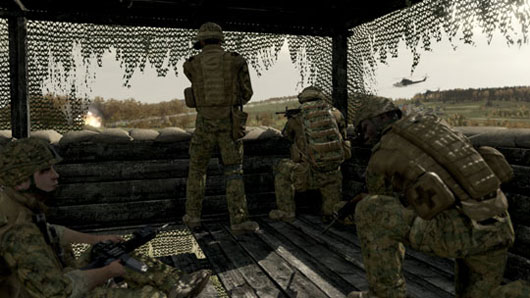
One feature which brought a bit of a break to the normal goings on of ArmA was ‘The Armory’ – a place where the gamer could try out the various weapons systems available in the game and take them on different challenges. BIS has brought the mode back in the sequel, and completing these challenges will result in more systems being unlocked for you to try. For instance, if you try the USMC M2-equipped Humvee, you could be asked to drive an obstacle course or even charge an enemy encampment! While not the main focus of the ArmA II, this mode provides a lot of entertainment in its own right.
Overall, Armed Assault II is an exceptional war-simulation that is just the thing for those gamers looking for extreme realism and depth. It definitely has its current stable of issues, but none of them are things that can’t be patched and, in the meantime, when the game runs as promised it really does feel like being part of a gritty and intense war. I can’t think of another title out there right now that fits the Armed Assault II bill in terms of its scope and multiplayer capabilities.
Speaking of which, I am Oscar Mike dear reader – have to get a game going. You can find more on Armed Assault II at the official game website.

LucasArts has announced that it will be streaming a special sneak-peek demo of their upcoming The Secret of Monkey Island: Special Edition this Friday, June 19th, at 3PM PST. Be sure to check back to this article to watch it live!
One of the biggest problems plaguing iPhone owners is battery life. In fact, it seems that most smart phones these days just don’t have the juice to make it more than four or five hours, if you’re lucky. This has given rise to the external battery pack market. But in the case of the iPhone, none of these solutions up until now have offered the flexibility, form, and function of the Mophie Juice Pack Air.
Compatible with the iPhone 3G as well as the new iPhone 3G S, the Mophie Juice Pack Air looks like pretty much any stylish iPhone case does. It is made from a hard, black plastic that offers a smooth shine and has rounded corners which make it look almost like an actual extension of your iPhone.
Inside the unit, though, you will find a lithium polymer, 1200 mAh battery which will provide about the same amount of power as the standard iPhone 3G’s battery will, so about 4.5 hours depending on usage. The best thing about the Juice Pack Air is that the design of the case, including the size of it’s battery, does not make the phone so large it cant fit in your pocket, unlike many battery packs out there.
The drawback to this smaller size is, of course, a limit to the size of the battery Mophie could put inside it. In many battery packs, which are just too large to be practical, you get up to three days of normal usage. With the Mophie, it is only double the amount of usage time but at least you can easily carry it around – you won’t need to shell out $50 dollars on a gadget shoulder-holster just to take the thing with you.
Another thing about the Juice Pack Air is that the case actually protects your phone. Unlike the larger cases out there, the Juice Pack Air closes around you iPhone, keeping the phone locked into place. This is in contrast to the cases which act as more of a mobile cradle, with no top cap to the case at all. This has always made me nervous as I am afraid that the iPhone would fall out of the case should it drop on the ground. With this Mophie unit it is staying put.
On the back of the Juice Pack Air you will find a four LED battery pack indicator. These light up, a pleasing blue hue, in sequence denoting the amount of charge in the case battery.
Near the bottom of the case’s front you will find port holes which lead to the speaker and microphone interfaces on the bottom of the iPhone. These help to funnel the sound, into and out of the phone, to the front instead of the bottom. This is mostly because it made more sense than drilling holes into the bottom of the Juice Pack Air, where they would have to fight the battery for position.
The one thing that could be improved upon, while a minor issue, is using a more direct iPhone dock pass-through port on the bottom of the Juice Pack Air. Currently, the iPhone will dock into the case and that connection is then transmogrified into a mini-USB port on the bottom of the case. The Juice Pack Air includes a mini-USB cable for you to use but getting accustomed to bringing that cable along instead of your standard iPhone cable takes some doing.
On the brighter side, the Juice Pack Air features an on/off switch located on the bottom of the case. This allows you to choose when and where you want to let the power flow. Some people like running the iphone down first and others prefer drawing from the extra battery first – the choice is now yours.
The Mophie Juice Pack Air is available in black, purple, and white and is compatible with both the iPhone 3G and 3G S. It retails for $79.95 at Mophie’s official site.
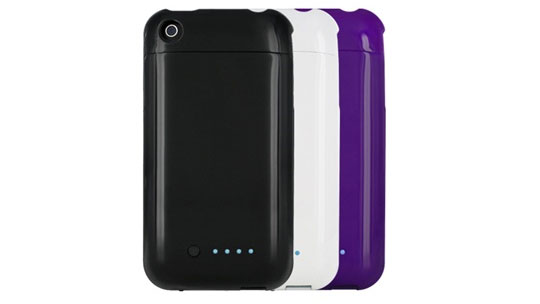

After the cancellation of Obsidian’s Aliens RPG, geeks everywhere knew that the future of the Aliens game franchise would rest with Gearbox Software’s Aliens: Colonial Marines. Back in February, unfortunately, we heard that Colonial Marines had been cut-back and delayed if not canceled entirely!
Now we have learned that Randy Pitchford, President of Gearbox Software, has told Kotaku that their long-anticipated Xenomorph shooter is, in fact, still in development, although he does mention it is not slated for this year.
Also, if you are big fans of the Aliens franchise and missed our media-only preview of Aliens vs Predator at E3 a couple weeks ago, check it out!
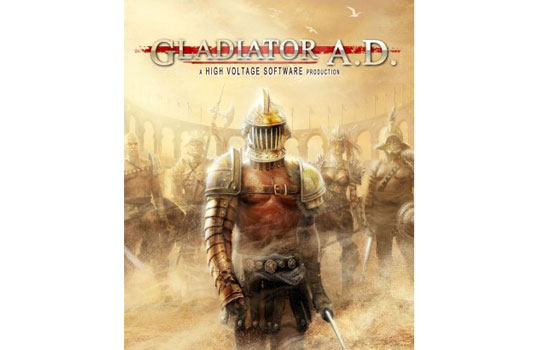
High Voltage Software is most well-known for their upcoming Nintendo Wii shooter, The Conduit. However, if you were so lucky as to have the proper media credentials and also get an appointment, you could get a look at two new titles they were previewing at the 2009 Electronic Entertainment Expo. While we had the credentials, we had no appointment. Even though the expo hall did not open until 10:00am on Wednesday morning, the good folks at High Voltage allowed us a look at the demo’s earlier in the morning.
One of the demo’s shown was The Grinder, an upcoming Left 4 Dead/Serious Sam-style shooter. The other was called Gladiator AD. While The Grinder will definitely warrant further examination, I wanted to tell you a bit about the game which could change the way you look at the Nintendo Wii forever: Gladiator AD… (Cont.)
(cont.) In its simplest terms, Gladiator AD is a mature fighting game where two opposing gladiators will duke it out in blood sport inside great coliseums and other arenas. Players will have many fighters to choose from, each with their own weapons, tactics, and abilities.
The two fighters we saw were a lumbering hulk of a man wielding a war club and a nimble woman who dual-wielded short swords. The game is not a really fast fighter but, rather, a more tactical match-up where button-mashing will not be rewarded. With the variety in each fighter, you really have to play to your strengths while exploiting your opponent’s weaknesses.
The most striking thing about Gladiator AD is its sheer brutality. In fact, it is the bloodiest game I have ever seen for the console and really shows that the Wii can be for adults too. High Voltage is filling a neglected Wii player segment with Gladiator AD. In the game, you will be able to do awful things to your enemy not only in combat but also with over-the-top finishing moves. For instance, in another demo fight, the war club-wielding behemoth obliterated another version of himself by literally bashing his opponent’s head clean-off with the club.
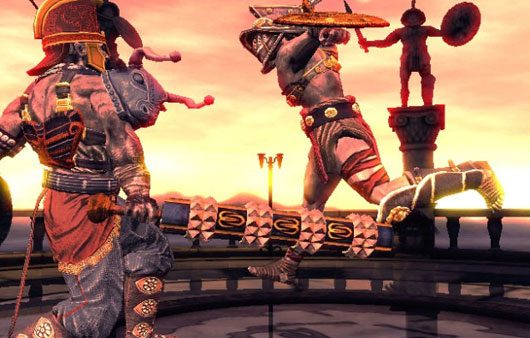
The brutality persists during the standard combat rounds of course, with fighters being able to knock-off their opponent’s armor and weapons. Fights can even come down to bare-knuckle brawls if both warriors lose their armaments…or even arms (hacking off a player’s arm is possible).
The two developers on-hand to show us this upcoming carnage-fest, Art Director Matt Corso and Design Director David Pellas, assured us that those of you who are merciful gladiators will not be left out in the cold either. There are other, non-fatal finishing moves that you can pull off on your enemy. Called ‘humiliations’, these finishers will not only make your opponent look bad but also win favor with the crowds in some case, which offers bonuses of its own.
Gladiator AD is not only about fighting though (well, most of it is) as each fighter features their own storyline as to their motivations in the gladiatorial games.
The game also features some really great visuals and audio, with a graphics engine that tries to compete on a level of the other big next-gen consoles and a musical score by ‘Rome’ composer Jeff Beal. According to the dev team they are not too far into production (roughly seven months) and are looking at a release sometime into 2010. From what we can tell it will be worth the wait. So, in the meantime, go make some popcorn and put on Ridley Scott’s Gladiator. You need practice!
E3 2009 Gladiator AD Trailer:

Phantom EFX, long-known for their vast line of casino games is shifting gears slightly and publishing Darkest of Days, a time-traveling shooter title being developed by 8Monkey Labs. While at this year’s Electronic Entertainment Expo, we were fortunate enough to get a behind closed-doors walk-through of the title.
The story of Darkest of Days is set, initially, in what we would call the future. At some point, mankind discovers time travel and begins research expeditions into the past. They are finding that someone has been changing the past as people who were recorded as dying at military battles and other major events in our history are living while others who were recorded as living are ending up dead… (Cont.)
(Cont.) Obviously, this represents a potentially world-altering threat as there is no telling how widespread throughout the time line such changes could effect. So, the agency responsible for the technology to begin with (‘Mother’s Organization’) starts sending back agents to these historical events to right the wrongs. This raises the question of just where, exactly, to get these agents? Having people from the future go back is out of the question as if they should die on a mission, it would be depriving the future of their existence (and could further alter the time line in the process).
Enter you, the player. In the walk through we received it showed the player starting as a member of General Custer’s 7th Cavalry at the Battle of Little Big Horn. During the course of the battle you receive some serious injuries and, before you die, time stands still as a portal opens up from the future. An agent walks out of it and recruits you to this organization. It would seem that Mother’s Organization found their agents in what the future would call M.I.A’s (or people who ended up ‘missing in action’). Since there is no record of what happened to these individuals, the organization feels they are their best hope of correcting the time line.

The game engine used by Darkest of Days, codenamed: ‘Marmoset’, was developed in-house at 8Monkey Labs and was made to accommodate a large number (hundreds) of characters on the screen at one time without a sizable performance loss. The game levels we saw played featured some very respectable visual quality and, yes, a ton of NPCs on both sides of the conflicts. When you travel back in time to the Battle of Antietam and you will be amazed at the sheer number of Confederate soldiers which charge from the cornfields at Union lines.
Thankfully, this is not just your normal shooter as if you make a mistake during the missions at hand, which could be killing too many of the wrong people or altering the course of the battle you will have to go back in time once more but as the ‘other side’ to balance these changes. The battlefields provided by the game are very large and while they have a number of scripted events they are largely sandbox-style in terms of what you can choose to do.
In the Antietam level the developers showed us, they decided to ‘chuck’ the orders at hand and single-handedly charge Confederate lines. The corn fields seemed to go one forever but, sure enough, at their end was the Confederate army complete with cannons.
Weaponry was a big issue for the developers as while they wanted to make use of historically-accurate weapons they also wanted to add a few big, futuristic armaments for the player to use. You need use these sparingly though, as it can alter the time line if you cut down rows of Civil War-era soldiers with your sub-machine gun. While cool and reminiscent of the opening scene in Time Cop, it just isn’t a good thing to do. The big coup de grace of the title looks to be a battle between Mother’s Organization time agents and their antithesis organization which is messing with history. It takes place in Pompeii during its historic (and devastating) eruption. Since all of those individuals are destined to die, both organizations see no problem with letting loose all the futuristic weapons and armor they can muster. After all, who are they going to tell?

The game also, at one point in its development history, featured a couple of the more controversial events in history, one of them being the terrorist attacks in New York on September 11th, 2001. One of your fellow time agents was a firefighter listed as missing during the tragedy. While it would have been respectfully-implemented, the developers chose to wait on telling those stories in such a vivid fashion. Although, according to at least one developer on-hand at the walk-through, it is still something they would like to explore at some point down the road (DLC perhaps?).
Personally, we hope they do: Video games depicting scenes of tragedy such as those (see the recently-canceled Six Days in Fallujah) may be hard to stomach at times but like all great art they have something to say beneath the surface, especially when handled respectfully with regards to history – something that the developers of Darkest of Days take to heart, first and foremost.
Darkest of Days looks to tell an intricate tale of time-travel, war, and the nature of fate all while featuring an in-game engine capable of some pretty surprising things. It is due out on the PC and Xbox 360 platforms on August 25th.

Hey there Shogunites! We were lucky to get a sneak preview (with hands on time) of Warner Brothers/Eidos’ Batman: Arkham Asylum at E3 2009. Thankfully, the game lives up to all the hype, and it’s not just another button masher. It’s free-form combat system, combined with mandatory stealth movement, make the game suspenseful, challenging, and dammit… exciting! (cont)
Story-wise, the Joker has taken control of Arkham Asylum in an attempt to lure Batman into a fatal trap. The Joker’s goons control the whole building and you, as Batman, have to work your way through the Asylum to pacify the facility, and re-capture the Joker.
The freeflow combat system is very well done. Instead of having to manuever Batman through a myriad of enemies, there are a limited number of attack buttons, and Batman chooses his enemies in a manner which kicks maximum ass. Lightening bolt-shaped indications above an enemy’s head indicate when Batman should press his counter-attach button. If your reaction time is good enough, Batman should mow through his enemies like Neo battling his way through a dozen incarnations of Agent Smith.
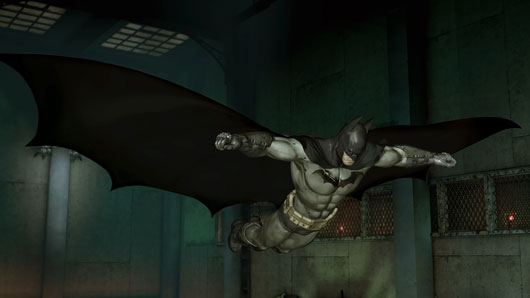
Batman doesn’t use firearms, of course, so the game is not just button mashing. In our hands on preview, we had to employ stealth more often than hand-to-hand combat. In Arkham Asylum, Batman has an ‘investigative’ mode where his cowl switches to a view which is part x-ray, part night vision. The game highlights objects Batman can interact with, and using this information, the player can stalk the night, taking enemies out one by one.
In our hands on preview, for example, we had to get past a number of armed guards. It only takes three or four shots to bring Batman down, so the goal is to be as quiet, and as stealthy as possible. Using the grappling hook, we went from corner to corner along the roof, occasionally swooping down on an enemy only to jump quickly out of sight again. This process requires a lot of thought and pre-planning. You can’t just jump in and be ready to melee your way through a fight. Your strength is in the shadows.
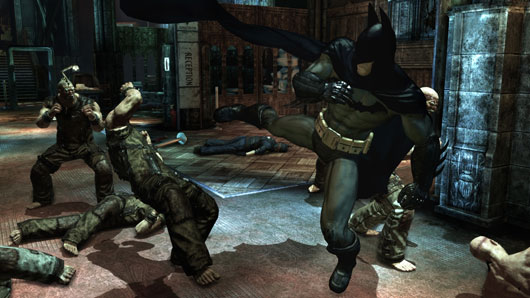
The developers we spoke with indicated that there were six major villains in the game: Zsasz, Poison Ivy, Bane, Killer Croc, Harley Quinn, and the Joker. We asked two different developers how much time it took to complete the game and received two strikingly different answers. One quoted us a play time of 10-15 hours, while another assured us the average was 25 hours.
In addition to the story mode, there are a number of quick play ‘challenge’ modes, where the player could choose to play as either Batman or the Joker through a number of scenarios.
Batman: Arkham Asylum comes out on August 25 on all platforms. Visit the official site and stay tuned for more info!
